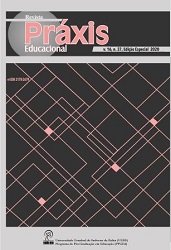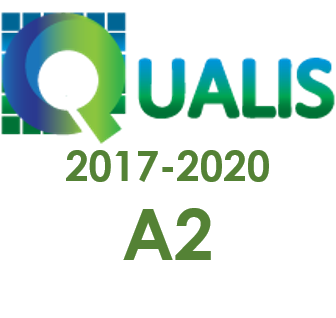DETERMINACIÓN DE LAS REDES SOCIALES EN EL CONTEXTO DEL CAMBIO SOCIAL, LA TECNOLOGÍA Y LA EDUCACIÓN SEGÚN LAS OPINIONES DE LOS ADMINISTRADORES ESCOLARES
DOI:
https://doi.org/10.22481/praxisedu.v16i37.6164Palabras clave:
Red social, Tecnología, Cambio social, AdministradoresResumen
Esta investigación se realizó de acuerdo con el formulario de entrevista semiestructurada desarrollado por los directores de las escuelas y los investigadores que trabajan en los distritos de Nicosia y Kyrenia en el año académico 2018/19. Dentro del alcance de la investigación, se ha discutido la dimensión del cambio social y el efecto de la tecnología en este proceso. La relación entre el cambio social y la tecnología se discutió en el contexto de la educación y luego se expresaron las situaciones que se realizaron por la interacción de tres conceptos. Además, se ha enfatizado que se pueden experimentar desarrollos positivos al beneficiarse del potencial de las redes sociales en el cambio social, la tecnología y el triángulo educativo, y que el mismo potencial puede ser perjudicial si se ignoran algunos casos.
Descargas
Métricas
Citas
Badri, M., Nuaimi, A., A., Guang, Y. and Rashedi, A., A. (2017). School perfomance, social networking effects, and learning of school children: Evidence of reciprocal relationships in Abu Dhabi, 1-12.
Balci, B. (2010). Success factors in the e-learning system. In U. Demiray, G. Yamamoto, M. Cut. (Eds.). E-learning in Turkey: Developments and applications (pp. 465-480).
Burnett, E., Lamm, A., Lucas, J., & Waters, R. (2009). Engaging stakeholders through social networking: how nonprofit organizations are using facebook. Public Relations Review, 35(2), 102-106.
Carr, N. (2006a). From transparency to trust. American School Board Journal, 193(9), 68-69.
Dabbagh, N. and Kitsantas, A. (2012). Personal learning environments, social media, and selfregulated learning: A natural for connecting formal and informal learning. The Internet and Higher Education, 15(1), 3-8. doi:10.1016/j.iheduc.2011.06.002formula.
Dağlı, G. ve Öznacar, B. (2015). Okul Yöneticilerinin, Öğretmenlerin ve Ailelerin Görüşlerine Göre İlköğretim Okullarının Yaygınlaştırma Uygulamalarına Bir Değerlendirme. Eğitim Bilimleri: Kuram ve Uygulama , 15 (5), 1317-1332.
Debeş, G., & Öznacar, B. (2018). Evaluation of the opinions of various actors on the school management of digitalization and management processes of the system engineering model in education. Amazonia Investiga, 7(16), 304-315.
Friedman, L.W., & Friedman, H.H. (2013). Using social media technologies to enhance online learning. Journal of Educators Online, 10(1), 1-22.
Gillet, D., El Helou, S., Yu, M. C., & Salzmann, C. (2008). Turning Web 2.0 social software into versatile collaborative learning solutions, 170-176). IEEE Computer Society Press.
Hall, D. (2006). Managing the communications. Learning & Leading With Technology, 33(6), 18-21.
Hampton, N., K. (2016). Social media and political discussion: when online presence silences offline conversation (Online). Retrieved from https://www.tandfonline.com/doi/full/10.1080/1369118X.2016.1218526
Herold, B. (2016, February 5). Technology in Education: An Overview. Education Week. Retrieved Month Day, Year from http://www.edweek.org/ew/issues/technology-in-education/
Hew, K., F. (2011). Students’ and teachers’ use of facebook, 662-676.
Hsieh, C.C., Yen, H.C. and Kuan, L.Y. (2014). The relationship among principals’ technology leadership, teaching innovation, and students’ academic optimism in elementary schools, International Conferences on Educational Technologies 2014 and Sustainability, Technology and Education, 113-120.
Huffman, S Education, 134(2), 154-160.. (2013). Benefits and pitfalls: Simple guidelines for the use of social networking tools in K-12 education.
Kaya, T. And Bicen, H. (2016). The effects of social media on students’ behaviors; Facebook as a case study, 374-379.
Köse, K., E., Yurdakul, Ö. ve Onuk, H. (2017). The Investigation of the relationship between school adninistrators leadership in technology and teachers’ students’ interaction in social media, 1-16.
Mason, R. (2006). ‘Learning technologies for adult continuing education’. Studies in Continuing Education, 121-133.
Mazman, G. S. and Usluel, K. Y. (2010). Modeling educational usage of Facebook, 444-453.
Mejias, U. (2005). Nomad's guide to learning and social software. Retrieved 19.05.2008, from. http://knowledgetree.flexiblelearning.net.au/edition07/download/la_mejias.pdf
Mitchell, S., Foulger, T. S., & Wetzel, K. (2009). Ten tips for involving families through internet-based communication. Young Children, 64(5), 46-49.
Öznacar, B., Dericioğlu, S. (2017). Teknoloji Kullanımında Okul Yöneticilerinin Rolü. Avrasya Matematik, Fen ve Teknoloji Eğitimi Dergisi , 13 (1), 253-268. https://doi.org/10.12973/eurasia.2017.00615a
Öznacar, B., Kan, Ş. G., Besim, S., & Şensoy, Ş. (2018). Assessment of the Effects of TV Programs Containing Violence on Children in Pre-school Period through the Views of Parents. BRAIN. Broad Research in Artificial Intelligence and Neuroscience, 9(4), 77-82.
Reuben, R. (2008). The use of social media in higher education for marketing and communications: A guide for professionals in higher education. Retrieved from http://doteduguru.com/wp-content/uploads/2008/08/social-media-in-higher education.pdf
Tiryakioğlu, F. and Erzurum, F. (2011). Use of Social Networks as an Education Tool, 135-150.
Descargas
Publicado
Cómo citar
Número
Sección
Licencia
Usted es libre de:
Compartir — copiar y redistribuir el material en cualquier medio o formato; Adaptar — remezclar, transformar y construir a partir del material para cualquier propósito, incluso comercialmente. Esta licencia es aceptable para Obras Culturales Libres. La licenciante no puede revocar estas libertades en tanto usted siga los términos de la licencia.
Bajo los siguientes términos:
Atribución — Usted debe dar crédito de manera adecuada, brindar un enlace a la licencia, e indicar si se han realizado cambios. Puede hacerlo en cualquier forma razonable, pero no de forma tal que sugiera que usted o su uso tienen el apoyo de la licenciante.
No hay restricciones adicionales — No puede aplicar términos legales ni medidas tecnológicas que restrinjan legalmente a otras a hacer cualquier uso permitido por la licencia.










